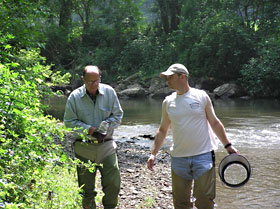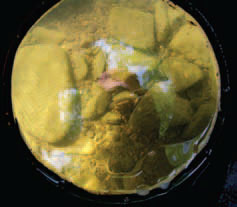Field Notes: Watery World through a Looking Glass
by Charles Bier

Standing on the banks of French Creek in northwestern Pennsylvania, one of my favorite streams, I knew the conditions were perfect on this sunny summer morning. As I began to wade in wearing my creek shoes, the water rushing past my legs was refreshing. I found the constant gurgling of the riffle soothing as well.
But this was “work,” so I had to get focused. I recalled that more than 25 years ago when I first started aquatic field studies, creeks were mysterious to me. A combination of moving water and surface glare meant that finding aquatic life, or even clearly seeing the bottom of a creek, kept many secrets of this watery world well hidden. Then I acquired a very important piece of scientific equipment: a homemade glass-bottom bucket.
So this morning at French Creek was now a typical experience. I waded out into knee-deep choppy water and looking down into the water I could not see a thing. Then, putting the bucket to use... voila, a thriving aquatic world. A glass-bottom bucket is like having your own personal glass-bottom boat.

WPC conservation staff members often use glass-bottom buckets for surveys.
Crayfish were scampering about the stream bed and I slowly moved over to see that two were involved in courtship. Standing still, the creek community returned to their activities, mostly paying little attention to me. I could now see several species of colorful darters. These are small bottom dwelling fish in the perch family and so attractive that it seems they ought to be denizens of a tropical coral reef, not a Pennsylvania stream. Looking through the bottom of my bucket I could see the aptly named rainbow darter and an orange and bright blue male variegated darter. After 30 minutes or so of these wonders, I found what I had actually come to the creek to find, a rare rabbitsfoot mussel, its striking green shell lying next to a log in deeper water. I would never have found it without the bucket. I continued for the next few hours surveying the creek for freshwater mussels and keeping field notes.
You too can enter the private lives of fish, mussels, salamanders and more, and I encourage you to get your own glass-bottom bucket and explore the streams in your area. Although a few outdoor supply companies sell them, or similar “viewers,” it is relatively easy to make your own. If you would like instructions for doing so, just send an email to: info@paconserve.org.
– Charles Bier is the senior conservation scientist for the Western Pennsylvania Conservancy.
